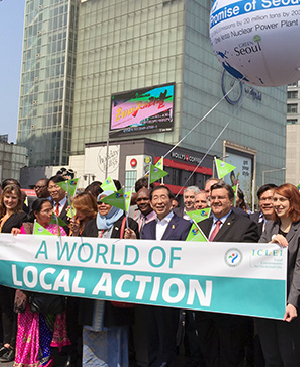- Home
- Reporting entities
- Lyon Metropolis
Lyon Metropolis
France-
Population 1324637

-
Area 533.68km 2
-
GDP 730 BillionUSD
-
Targets by N/A N/Aemission
Targets by Lyon Metropolis
There are no targets yet
- Start year: 2010
- Type: Public Participation/Stakeholder engagement
- Status: Completed
Greater Lyon has led for several year a political program to promote alternatives to private cars : carpooling websites and infrastructures, carsharing offers (electrical in 2014), bicycle infrastructure and public bikes. Beyond technical infrastructures, information is a key element of our strategy. Therefore, Greater Lyon has been involved since 2011 in 2 european projects to set up an intermodal information database. Optimod'Lyon (2011-2013) and Opticities (2014-2017) projects developp several tools : a platform (Onlymoov, delivered in 2014) gives real-time information on traffic, public transports (bus, car, bicycle) including works and accidents. A prevision of traffic 1 hour ahead, as well as a lmobile application comparing different transport options is in process.
Read More Read Less- Transport
- Start year:
- Type: Public Participation/Stakeholder engagement
- Status:
Lyon confluence is one of the major urban project in europe. The purpose is to extend the city centre by constructing 1 000 000 sqm of new dwellings and offices in 2025 and keep the level of Co2 emission of the year 2000! How can we do that? 1/ reduce the energy consumtion of the existing buildings. 2 /Build positive energy smart building. 3/Produce renewable energy thanks to Pv rooftops and congeneration heating district that will produce heat and electricity with biomass!
Read More Read Less- Transport
- Start year: 2012
- Type: Technical/Infrastructure investment
- Status: In operation
One of the key elements to achieve a -20% scenario for greater lyon is investment in the energetical rehabilitation of houses and buildings, that represent 1/3 of the territory's emissions. Since 2012, a subvention has been set up to help public constructors (social housing) rehabilitate 2000 appartments up to a very performant level (less than 96 kWhep/year). An experimental phase is also in process for private housing (1200 appartments), the engineering being a key factor as decision has to be taken collectivelly between owners. The experiment will be enlarged in 2015 with additional financial support (around 15% of the price of the works) and help to build the project, fetch other financial support and animate decision-making between owners of a building.
Read More Read Less- Start year:
- Type: Regulatory
- Status: Completed
Greater Lyon has enforced for several years a rainwater polical programme to reduce stormwater peaks and manage rainwater locally. Measures include : integrated solutions when rehabilitating a public zone (stormwater lakes, raingardens, roofwater recuperation for public gardens...) ; reglementation (it is forbidden to connect rainwater to the sewerage network) as well as technical guidelines to help architects and promoters implement these techniques. A local partnership with research (OTHU) allows a scientifical feedback.
In 2013-2014, Greater Lyon hosted the international conference "novatech" and participated to the european project "Aqua ADD" that studies the economical benefits from blue and green solutions.
- Human health
- Start year: 2010
- Type: Assessment/Research
- Status: In operation
The city's main vulnerability is an increase of average temperatures wich is amplifyed by the minerality. Since 2012, a cooperation has started with local research and a private partner, Veolia Environnement. A PHD produced a climatic model of the city and maps of prioritary zones, while the enterprise tested a real-size model of a streat humidification device.
Next developpments will be, for 2014-2015, the creation of a scientifical comittee in charge of designing an "observation tool" (sensors + social approach).
- Human health
The Lyon Metropolis has reported 1 Community emission inventory, since 2010. In its latest inventory, compiled in 2010, the Stationary energy, Transport, Agriculture, forest and other land use and Agriculture, forest and other land use are identified as key emission sources.
The Lyon Metropolis has reported 1 government operational inventory, since 2009. In its latest inventory, compiled in 2009, the Waste management, Transport and Other are identified as key emission sources.


